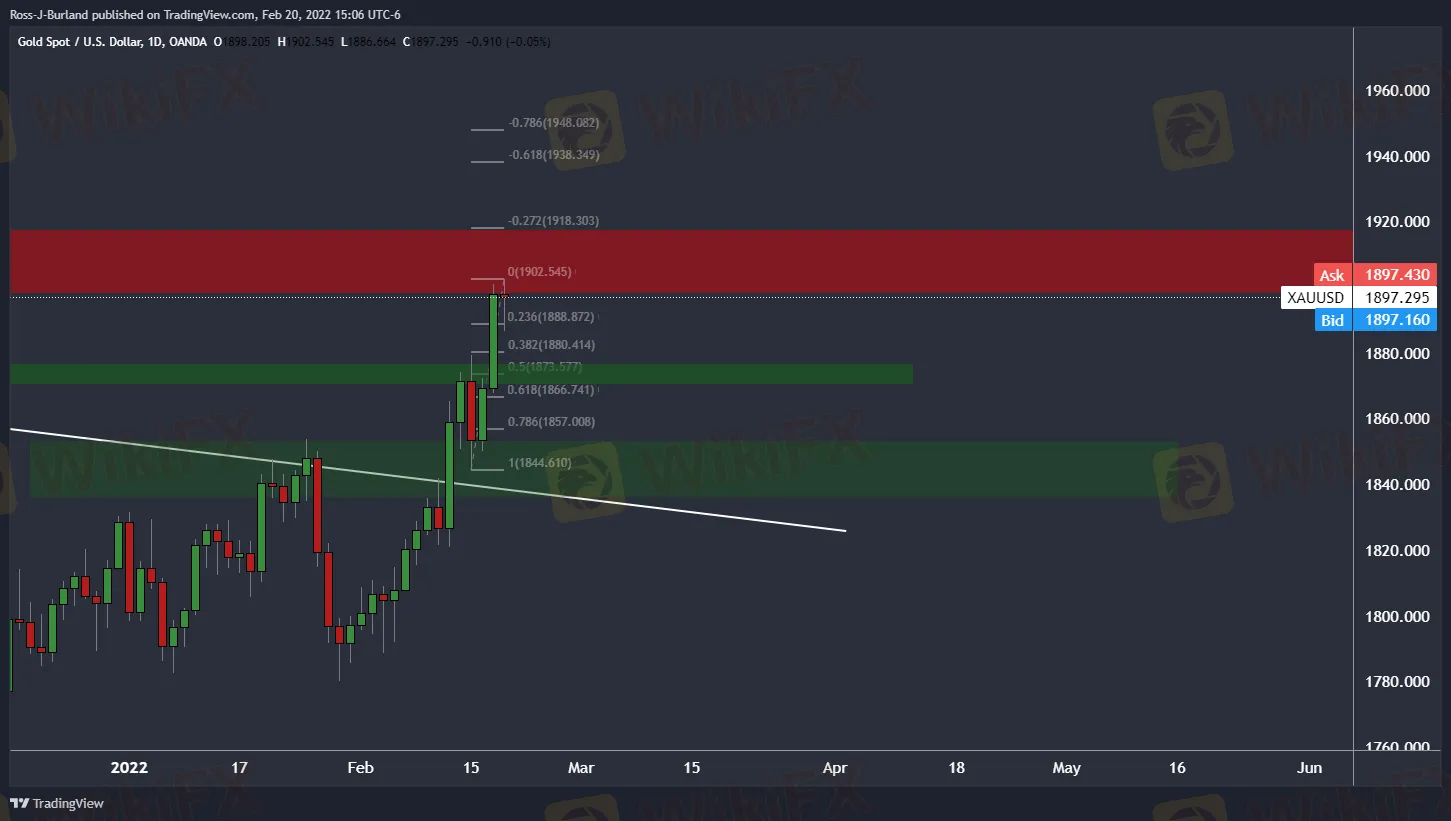简体中文
繁體中文
English
Pусский
日本語
ภาษาไทย
Tiếng Việt
Bahasa Indonesia
Español
हिन्दी
Filippiiniläinen
Français
Deutsch
Português
Türkçe
한국어
العربية
Gold Price Forecast: XAU/USD renews multi-day high above $1,900 amid risk-aversion
Abstract:In doing so, the yellow metal extends the previous three-week uptrend to refresh an eight-month high as traders rush to risk-safety amid escalating concerns over the Russia-Ukraine issue.

Gold bulls are meeting critical resistance, all eyes on Fed speakers and Russian diplomacy.
A break of $1,890 could be on the cards for the opening sessions.
Update: Gold (XAU/USD) takes the bids to poke June 2021 highs, up 0.60% intraday around $1,910 during Mondays Asian session.
Recently, a Reuters‘ witness mentioned that an explosion was heard in the center of the rebel-held city of Donetsk in eastern Ukraine. That said, the US continues to suggest an imminent Russian military attack on Ukraine even as Moscow rejects the claims. It’s worth noting that a diplomatic meeting between US Secretary of State Antony Blinken and Russian Foreign Minister Sergei Lavrov is the ray of hope to witness de-escalation of the geopolitical fears and hence can test XAU/USD bulls.
While portraying the risk-off mood, S&P 500 Futures drop 0.50% on a day while the US Dollar Index (DXY) and Treasury yields remain pressured.
It should be observed, however, that the recently downbeat US inflation expectations, as measured by the 10-year breakeven inflation rate per the St. Louis Federal Reserve (FRED) data, also add to the gold buyers‘ optimism ahead of this week’s key inflation numbers.
End of update.
Gold, XAU/USD, was little changed on Friday, but the trend followers are still engaged with traders seeking safe-haven assets. Stocks slid in Europe and on Wall Street while safe-haven government debt prices rose due to increased shelling in Ukraine's East and a tough stance from Russia is unsettling financial markets.
XAU/USD ranged between $1,886.66 and $1,902.54 on Friday ending flat on the day while more warnings from the US that a Russian invasion is imminent continued to put pressure on risk sentiment on Friday night, with developments likely to be a key driver of markets this week, analysts at ANZ Bank said. ''The US has warned that multiple cities could come under attack, causing significant civilian casualties, while Russia continues to deny any plans to invade.''
Meanwhile, the Federal Reserve hangs over prices like a knife on a string. ''Looking forward, however, the crushing weight of a hawkish Fed will ultimately sap appetite for precious metals,'' analysts at TD securities argued. ''Without sustained buying behaviour, gold prices are unlikely to remain in an uptrend, particularly as real rates rise sharply amid dual tightening via hikes and quantitative tightening. However, if gold prices are going to succumb to this macro regime as we expect, then CTAs are accumulating at the top.''
For the week ahead, there is plenty going on from the economic calendar. We will have a chorus of Fed speakers and the PCE report as well as Markit PMIs. ''Fed officials will remain occupied this week trying to guide the market ahead of the March FOMC meeting and following signs of persistent data strength in Q1, particularly on inflation,'' analysts at TD Securities said. ''Most focus will be centred on Governor Waller, who will be discussing the US economic outlook on 24 February. Presidents Bostic, Barkin and Mester are also scheduled to deliver remarks.''

Disclaimer:
The views in this article only represent the author's personal views, and do not constitute investment advice on this platform. This platform does not guarantee the accuracy, completeness and timeliness of the information in the article, and will not be liable for any loss caused by the use of or reliance on the information in the article.
Read more

Blockchain Decentralization: Empowering a Trustless Future
In recent years, blockchain technology has rapidly evolved from a niche innovation behind Bitcoin into a transformative force across industries. At its core, blockchain decentralization refers to the distribution of authority and decision-making away from a central entity and into the hands of a distributed network of participants. This shift redefines how data is stored and verified and paves the way for trustless, transparent, and resilient systems that challenge traditional centralized models.

The president of @Liberland, @Vít Jedlička come on stage, dialogue on trading security.
The 2025 WikiEXPO Hong Kong Station is about to grandly open. the president of @Liberland, @Vít Jedlička come on stage, dialogue on trading security.

Countdown: 1 day.WikiEXPO2025's first stop, Hong Kong, is about to open.
⏰ Countdown: 1 day. WikiEXPO2025's first stop, Hong Kong, is just tomorrow. Focus on transaction security and explore new investment opportunities. ???? Get ready to start now. See you tomorrow.

JustForex vs JustMarkets: A Comprehensive Comparison in 2025
Selecting the right forex broker can make the difference between trading success and frustration for most investors, especially retail investors. As retail traders gain unprecedented access to global markets, the choice between platforms like JustForex and JustMarkets becomes increasingly significant. Both brokers offer some shining features within the forex and CFD trading space, but their approaches differ in some areas.
WikiFX Broker
Latest News
The Withdrawal Trap: How Scam Brokers Lure Victims into Paying More
FCA to Investors: Think Twice Before Trusting These Brokers
Trump\s tariffs: How could they affect the UK and your money
Trump gambles it all on global tariffs he\s wanted for decades
TradingView Brings Live Market Charts to Telegram Users with New Mini App
Trump tariffs: How will India navigate a world on the brink of a trade war?
Interactive Brokers Launches Forecast Contracts in Canada for Market Predictions
Authorities Alert: MAS Impersonation Scam Hits Singapore
Stocks fall again as Trump tariff jitters continue
IG Group Acquires Freetrade for £160M to Expand UK Investment Market
Currency Calculator







